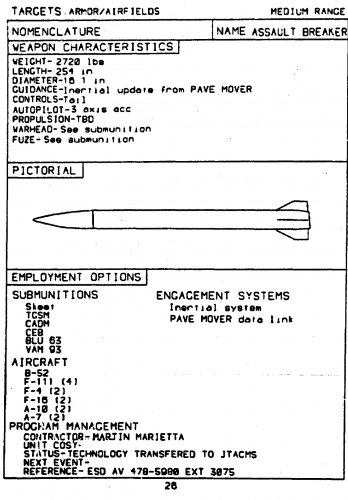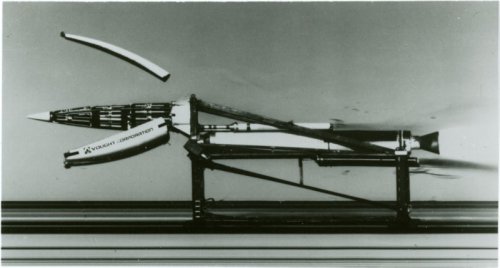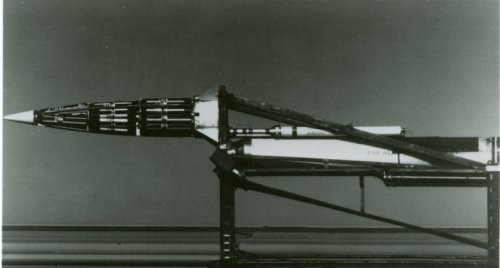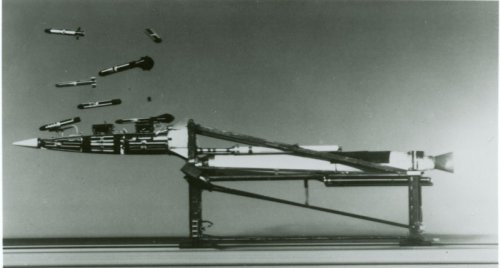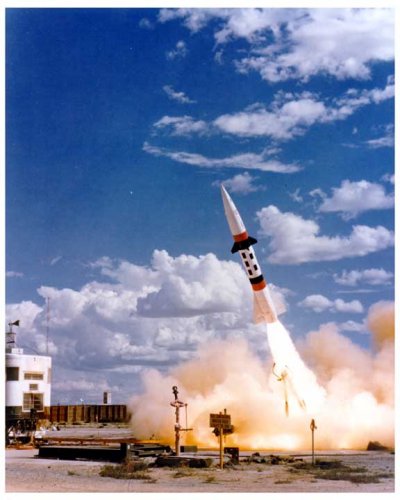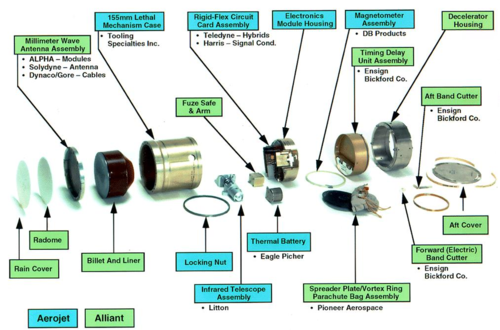You are using an out of date browser. It may not display this or other websites correctly.
You should upgrade or use an alternative browser.
You should upgrade or use an alternative browser.
Assault Breaker
- Thread starter sferrin
- Start date
The Wasp min-missile is interesting - the CONOPS is very similar to that envisioned for BRIMSTONE, allthough the latter employs more conventional triple launchers. (I've got an article on perhaps the "ultimate" assult breaker - the "Rods From God" (they were *real*) somewhere. I'll post it later.)
RP1
RP1
- Joined
- 3 June 2011
- Messages
- 17,897
- Reaction score
- 10,979
RP1 said:The Wasp min-missile is interesting - the CONOPS is very similar to that envisioned for BRIMSTONE, allthough the latter employs more conventional triple launchers. (I've got an article on perhaps the "ultimate" assult breaker - the "Rods From God" (they were *real*) somewhere. I'll post it later.)
RP1
If you notice it shows a Pershing II RV dispensing "Rods from God". I've also got a picture in an old MilTech issue of another one, much larger, doing the same. They even mention a "dead-airbase-in-a-package" based on the Saturn V of all things.
Saturn V
I raise your Launch Vehicle and present an orbital strike weapon:
From Jane's International Defence Review, Jan 2006:
..."One conventional strike option against hardened targets was demonstrated under a "black" or classified programme in 1978-88. Colliquially known as "rods from God" (a term attributed to science fiction writer Jerry Pournelle), it involved placing small space vehicles containing 15-20 long, dense, inert tungsten rods - 6m long and 0.3m in diameter - in elliptical orbits around the Earth. (There is no treaty restricting the use or deployment of conventional or non-explosive orbital weapons.) The vehicles would achieve ultra-high apogees of almost 65,000km and would eject and de-orbit the rods on demand. When something falls in a vacuum from 65,000km it is apt to be moving rather quickly when it hits the ground, and the concept involved impact speeds of 6,000m/s. It was estimated that the sheer kinetic energy impact would be enough to destroy missile silos. According to analyst Barry Watts of the Center for Strategic and Bugetary Assessments: "A total of perhaps USD70-80 million was spent... including test shots against the Kwajalein Atoll from Vandenberg AFB in California. In the end, however, the programme met staunch opposition from Air Force fighter generals who were not interested in seeing SAC develop a non-nuclear global-strike capability. As a result, the programme was terminated."...
Anyone here read Footfall?
RP1
- Joined
- 3 June 2011
- Messages
- 17,897
- Reaction score
- 10,979
RP1 said:Saturn V
I raise your Launch Vehicle and present an orbital strike weapon:
From Jane's International Defence Review, Jan 2006:
..."One conventional strike option against hardened targets was demonstrated under a "black" or classified programme in 1978-88. Colliquially known as "rods from God" (a term attributed to science fiction writer Jerry Pournelle), it involved placing small space vehicles containing 15-20 long, dense, inert tungsten rods - 6m long and 0.3m in diameter - in elliptical orbits around the Earth. (There is no treaty restricting the use or deployment of conventional or non-explosive orbital weapons.) The vehicles would achieve ultra-high apogees of almost 65,000km and would eject and de-orbit the rods on demand. When something falls in a vacuum from 65,000km it is apt to be moving rather quickly when it hits the ground, and the concept involved impact speeds of 6,000m/s. It was estimated that the sheer kinetic energy impact would be enough to destroy missile silos. According to analyst Barry Watts of the Center for Strategic and Bugetary Assessments: "A total of perhaps USD70-80 million was spent... including test shots against the Kwajalein Atoll from Vandenberg AFB in California. In the end, however, the programme met staunch opposition from Air Force fighter generals who were not interested in seeing SAC develop a non-nuclear global-strike capability. As a result, the programme was terminated."...
Anyone here read Footfall?
RP1
Peter F Hamilton also uses it in his Night's Dawn trilogy (excellent sci-fi BTW if you're into that).
- Joined
- 6 August 2007
- Messages
- 3,371
- Reaction score
- 3,567
blackstar said:There's a detailed discussion of Assault Breaker in the DARPA multi-volume history posted here awhile ago. Not many pictures, but lots of history.
The three "DARPA Technical Accomplishments" volumes referenced here I believe:
http://www.darpa.mil/About/History/Historical_DARPA_Bibliography.aspx
- Joined
- 17 May 2008
- Messages
- 678
- Reaction score
- 1,401
Void
ACCESS: Confidential
- Joined
- 1 March 2008
- Messages
- 136
- Reaction score
- 48
That looks like the front end of the T22 to me... (which was Vought's Assault Breaker design)
These aren't about Assault Breaker specifically, but they do discuss it:
http://www.princeton.edu/~ota/disk2/1987/8718/8718.PDF
http://www.fas.org/ota/reports/8630.pdf
These aren't about Assault Breaker specifically, but they do discuss it:
http://www.princeton.edu/~ota/disk2/1987/8718/8718.PDF
http://www.fas.org/ota/reports/8630.pdf
- Joined
- 3 June 2011
- Messages
- 17,897
- Reaction score
- 10,979
Void said:That looks like the front end of the T22 to me... (which was Vought's Assault Breaker design)
These aren't about Assault Breaker specifically, but they do discuss it:
http://www.princeton.edu/~ota/disk2/1987/8718/8718.PDF
http://www.fas.org/ota/reports/8630.pdf
You're probably correct. The T-22 had forward fins added to a Lance rocket (Vought).
http://www.designation-systems.net/dusrm/app4/assault-breaker.html
Attachments
pathology_doc
ACCESS: Top Secret
- Joined
- 6 June 2008
- Messages
- 1,561
- Reaction score
- 1,415
sferrin said:a "dead-airbase-in-a-package" based on the Saturn V of all things.
That would certainly do the job, although it would have to be one hell of an airbase to warrant spending that level of resources.
The problem with such things is the possibility that the other side will take such a high-arching shot as presumptive evidence of a nuclear strike. It's only safe to do if said other side either is not nuclear armed or is content to wait for the first mushroom to blossom before returning the favour with interest. Also: given that even a conventional explosion of sufficient severity can generate a convincing mushroom cloud, you'd better not be using depleted uranium in those rods or someone with twitchy fingers is going to take the hit (and the resultant kick from the geiger counters) as evidence of a ground burst and then it's hasta la vista m.f.
- Joined
- 16 April 2008
- Messages
- 9,051
- Reaction score
- 12,821
pathology_doc said:Also: given that even a conventional explosion of sufficient severity can generate a convincing mushroom cloud, you'd better not be using depleted uranium in those rods or someone with twitchy fingers is going to take the hit (and the resultant kick from the geiger counters) as evidence of a ground burst and then it's hasta la vista m.f.
The whole point of depleted uranium is that it's NOT significantly radioactive. DU is what's left after you separate out most of the short-half-life isotopes to make enriched uranium.
There's no way anyone would mistake a conventional warhead detonation for even a small nuke -- we're talking orders of magnitude difference here, even from just the thermal effects.
Of course, since launch-on-warning was the general rule for much of the Cold War, it was still devilishly dangerous to play with such things.
- Joined
- 6 August 2007
- Messages
- 3,371
- Reaction score
- 3,567
RP1 said:From Jane's International Defence Review, Jan 2006:
..."One conventional strike option against hardened targets was demonstrated under a "black" or classified programme in 1978-88. Colliquially known as "rods from God" (a term attributed to science fiction writer Jerry Pournelle), it involved placing small space vehicles containing 15-20 long, dense, inert tungsten rods - 6m long and 0.3m in diameter - in elliptical orbits around the Earth. (There is no treaty restricting the use or deployment of conventional or non-explosive orbital weapons.) The vehicles would achieve ultra-high apogees of almost 65,000km and would eject and de-orbit the rods on demand. When something falls in a vacuum from 65,000km it is apt to be moving rather quickly when it hits the ground, and the concept involved impact speeds of 6,000m/s. It was estimated that the sheer kinetic energy impact would be enough to destroy missile silos. According to analyst Barry Watts of the Center for Strategic and Bugetary Assessments: "A total of perhaps USD70-80 million was spent... including test shots against the Kwajalein Atoll from Vandenberg AFB in California. In the end, however, the programme met staunch opposition from Air Force fighter generals who were not interested in seeing SAC develop a non-nuclear global-strike capability. As a result, the programme was terminated."...
Anyone here read Footfall?
RP1
Gosh, that sounds a lot like the Martin CAM.
pathology_doc
ACCESS: Top Secret
- Joined
- 6 June 2008
- Messages
- 1,561
- Reaction score
- 1,415
TomS said:The whole point of depleted uranium is that it's NOT significantly radioactive. DU is what's left after you separate out most of the short-half-life isotopes to make enriched uranium.
...
There's no way anyone would mistake a conventional warhead detonation for even a small nuke
I stand corrected on the DU. On the other hand, I was trying to imply that such a "mistake" would be made by persons somewhere between unreasonable and crazy, who wanted an excuse to push the button in return and didn't care how much the truth had to be bent/ignored to justify what they did (cf. "Nazi A-bomb" claims and moon hoax conspiracies).
- Joined
- 9 October 2009
- Messages
- 21,147
- Reaction score
- 12,249
A little more info on Assault Breaker, via a summary of another program [MLRS Terminal Guidance Warhead (TGW)]:
http://www.dtic.mil/dtic/tr/fulltext/u2/a101306.pdf
G. (U) RELATED ACTIVITIES: The Under Secretary of Defense for Research and Engineering directed the Defense Advanced
Research Projects Agency (DARPA) to develop the emerging technologies and demonstrate the potential of a Long-range antiarmor
capability. The resulting DARPA technology demonstration, known as "Assault Breaker," will use a long-range Army carrier
missile with midcourse correction capabilities, an Air Force radar system to locate/track targets, and provide guidance to
the carrier missile, submissiles with infrared terminal homing TGSH (Terminally Guided Submunitions), and nonhoming
target-sensing submunitions called SKEET. The demonstration is to be conducted from January to November 1981. The Army,
through its Missile Command, has been directly involved as the contracting and coordinating agency for DARPA to obtain and
test the carrier missiles, submissiles, and submunitions. Although Assault Breaker was not initiated to validate NLRS-TGW.
MLRS has influenced how DARPA has proceeded through the initial stages of its demonstrations. The most significant MLRS
influence is the sizing of the TGSM. DARPA's TGSH was sized 4" x 25" so that six of them could be packaged into the MLRS
warhead. At this juncture, no incompatibilities have been found between Assault Breaker and the seeker requirements that are
visualized for the MLRS TGSH. The MLRS-TGI program schedule was also established so that the Concept Definition studies
would begin just as the Phase III Assault Breaker demonstrations terminated. This plan will assure the availability of a
maximum amount of data, both to contractor and government representatives. These data will also be invaluable to the team
that will evaluate the Concept Definition studies. The Assault Breaker seeker technology will provide the baseline for the
MILRS-TGW. Day-to-day involvement of the Army Missile Command's Advanced Systems Concepts Office in the Assault Breaker demonstrations
assures that the potential for duplication between Assault Breaker and MLRS-TG is minimized.
http://www.dtic.mil/dtic/tr/fulltext/u2/a101306.pdf
- Joined
- 31 December 2006
- Messages
- 800
- Reaction score
- 352
DARPA revives Assault Breaker concept, this time with with greater stand-off range.
https://aviationweek.com/defense/darpa-revives-cold-war-breakthrough-russia-and-china-war-scenario
Not too much technical detail, but interesting as an organizing principle. May be behind the firewall for a week or so.
https://aviationweek.com/defense/darpa-revives-cold-war-breakthrough-russia-and-china-war-scenario
Not too much technical detail, but interesting as an organizing principle. May be behind the firewall for a week or so.
Forest Green
ACCESS: Above Top Secret
- Joined
- 11 June 2019
- Messages
- 7,901
- Reaction score
- 13,350
Forest Green
ACCESS: Above Top Secret
- Joined
- 11 June 2019
- Messages
- 7,901
- Reaction score
- 13,350
Surprised no one has mentioned Tacit Blue, which was intended to operate behind enemy lines using stealth and SAR to target enemy ground forces.


- Joined
- 9 October 2009
- Messages
- 21,147
- Reaction score
- 12,249
Regarding TGSM work in the 1970s, from International Defense Review July 1975:
EDIT: Correction, it was June of 1975.
LTV is meanwhile developing a TGSM conventional warhead for Lance containing 9 laser-homing anti-tank sub-missiles. Development is
proceeding at a slow rate under company funding however, and it is reported that only one test firing has taken place so far. Slow pace
of development is thought to be due to be the difficulty in preventing all 9 submissiles from homing onto the same tank.
EDIT: Correction, it was June of 1975.
Last edited:
Forest Green
ACCESS: Above Top Secret
- Joined
- 11 June 2019
- Messages
- 7,901
- Reaction score
- 13,350
Lance?Regarding TGSM work in the 1970s, from International Defense Review July 1975:
LTV is meanwhile developing a TGSM conventional warhead for Lance containing 9 laser-homing anti-tank sub-missiles. Development is
proceeding at a slow rate under company funding however, and it is reported that only one test firing has taken place so far. Slow pace
of development is thought to be due to be the difficulty in preventing all 9 submissiles from homing onto the same tank.
- Joined
- 9 October 2009
- Messages
- 21,147
- Reaction score
- 12,249
MGM-52 Lance tactical surface-to-surface missile. Originally only nuclear armed (work on conventional and chemical versions had been shelved at the beginning of the 1970s), work on a conventional version armed primarily with a M215 cluster munitions warhead, initially known as Conventional Lance and based on the MGM-52C, had just resumed in 1975. The TGSM warhead was intended as an alternative payload.
Last edited:
Similar threads
-
-
Contested air assault in the modern era?
- Started by shin_getter
- Replies: 23
-
Can ballistic missiles be used as anti-shipping weapons?
- Started by Sentinel Chicken
- Replies: 42
-
-
Swimmer Delivery Vehicle projects, old and new
- Started by covert_shores
- Replies: 166

